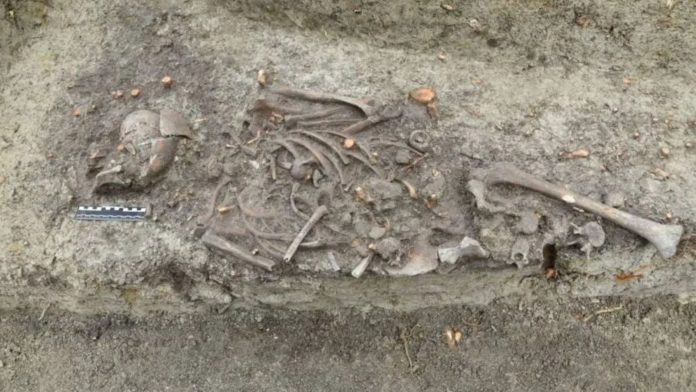Unveiling the Macabre: New Discovery of ‘Vampire Children’ Graveyard in Poland!
In a chilling revelation that has gripped the hearts and imaginations of many, researchers have unearthed a medieval graveyard in Koszalin, Poland, that houses what are known as “vampire children.” This grim discovery has led to both intrigue and horror as archaeologists uncover the secrets that lie buried beneath the soil—a testament to the historical fears surrounding the undead.
Unearthing ‘Vampire Children’ in Poland
The excavation site, located on the ridge known as Góra Chełmska, revealed two child skeletons buried in pits devoid of coffins, hinting at a culturally unique caretaker of these little ones. Local folklore from the era described vampires as revenants—creatures that return to torment the living. The peaceful resting place of these children was anything but ordinary. Archaeologists found signs indicating a “revenant burial,” reflecting a widespread European practice aimed at preventing the dead from rising.
The Eye-Opening Findings of Anti-Vampire Burials
What lies within these graves goes beyond mere curiosity; it dangles at the edge of superstition and historic memorial practices. These children were interred with heavy stones atop their bodies, a tactic employed to thwart any potential resurrection. Archaeologists noted that the positioning of the remains was intentional, with the skeletons lying on their backs and their skulls facing west, adhering to ancient burial customs.
The condition of the graves provides insight into the “anti-vampire burial” methods that were widely known across Europe during the 13th century. These measures included placing large stones against the legs of the deceased and occasionally stabbing the body with a lance to anchor it to the ground.
The Rituals Behind the Graves of ‘Vampire Children’
One of the children uncovered had undergone additional horrifying treatment; it was decapitated, with the skull turned downward and heavy stones resting on its torso. This gruesome custom—burying individuals face down—was believed to ensure that if they reanimated, they would bite into the earth rather than seeking out human prey. Pillars marking the grave indicate a burial site specifically set apart from other known locations in the area, showing a unique approach to these particularly unnerving internments.
Historians and archaeologists have reflected on the cultural significance of these discoveries. “Burying with the face to the ground, cutting off the head, or pressing the body down with heavy stones were common methods used to prevent a suspected demonic being from escaping the grave,” noted one of the conservators from the Lublin Provincial Conservator of Monuments.
Insights into the Historical Context of Vampire Myths
This grim discovery not only piques the interest of archaeologists but also invokes a broader understanding of societal fears surrounding death and rebirth in medieval Europe. Vampires and the superstition surrounding them can be traced back to as early as the 11th century, with various instances of skeletons being buried with similar precautions surfacing throughout Eastern Europe.
Similar to a recently unearthed graveyard in the village of Pien, where another set of “child vampires” was found, these patterns of burial expose a layer of deeply rooted fears about death and the afterlife. In Pien, notable burial rituals involved children being laid to rest face down, with one child even discovered with its foot locked in a padlock—further indicating the lengths to which villagers would go to protect themselves from presumed threats.
The Importance of Historical Analysis
As archaeological methods evolve, the analysis of these graves will dive deeper into understanding burial rituals steeped in myth and superstition. The researchers aim to unravel the enigmatic lives of these children and place their stories into the larger narrative of human history.
While such archaeological findings might send shivers down one’s spine, they also enrich our understanding of how societies have grappled with death, superstition, and the notion of eternal life.
In conclusion, the recent unveiling of the “vampire children” graveyard in Poland serves as a haunting reminder of the complexities of life, death, and belief systems that spanned across centuries. As we peel back the layers of these dark tales, we can better appreciate the cultural contexts that defined the lives of those buried beneath the soil—leading us into a realm where history, horror, and humanity intertwine.

